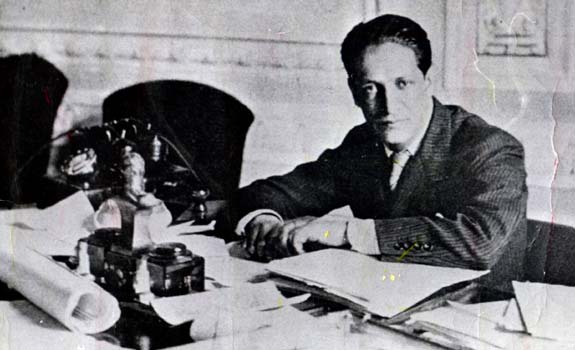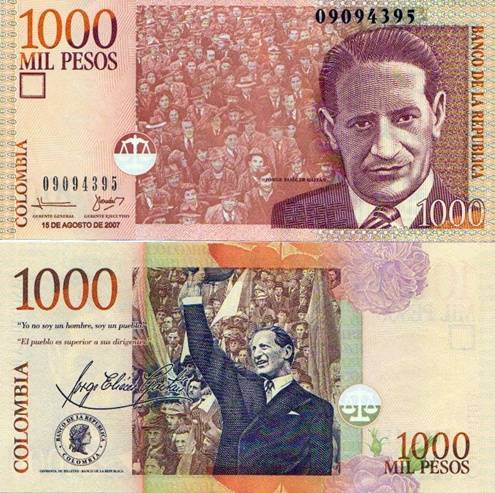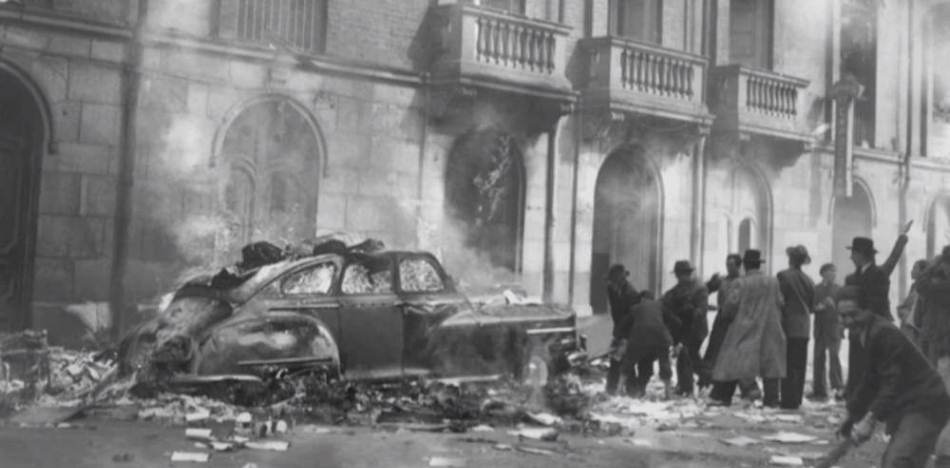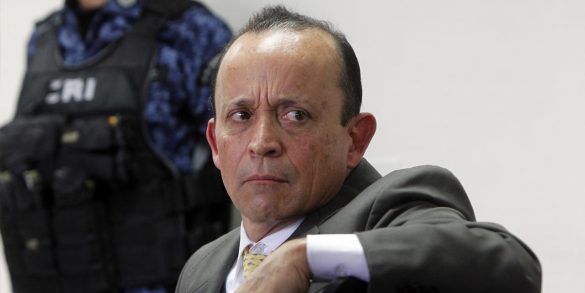Judi Lynn
Judi Lynn's JournalThese problems have been going on since 1946, over 70 years ago, a bit farther back than Chavez.
Sorry, the facts have very little to do with lions, or with Chavez, or with Maduro.
Summary of the violent conflict which has lasted so long in Colombia:
La Violencia in Colombia
The transfer of power in 1946 ignited tensions between the Liberal and Conservative parties, resulting in violent political conflict, particularly in rural areas. The loss of peace foreboded the return to competitive and exclusionary politics, similar to the situation preceding the War of a Thousand Days. In the 1940s and 1950s, however, violence and exclusion more than threatened the political system; they ruptured it. A democratically elected administration became repressive and dictatorial, which led to its overthrow by the sole military coup in the twentieth century. Only by having the reins of power taken from both of their hands did the traditional elites recognize that the most effective way to avoid interparty civil wars and possible military dictatorships was to join forces and restrain their competitive tendencies.
In 1946 Conservative Mariano Ospina Pérez assumed office and was faced with the difficult task of ruling from a minority position, as Liberals had received the majority of all presidential votes and continued to control Congress. Ospina tried to confront this situation by incorporating Liberals into a coalition government. Meanwhile, the level of political rivalry intensified in the countryside, where Conservatives pursued a course of violence in an attempt to consolidate power after sixteen years out of office. Liberals retaliated and, under Jorge Eliecer Gaitán's leadership, became highly mobilized in their demands that the Ospina government confront the social needs of the modernizing and urbanizing nation.
Gaitanism, the populist social movement led by Gaitán as a faction of the Liberal Party, increased dramatically between 1946 and 1948. Gaitán supported the democratic rather than the revolutionary path to reforms. By advocating the passage of more socially liberal policies, he appealed to the masses and he united urban workers and campesinos. As the movement grew, observers believed that Gaitán would be elected president, which may have happened had he lived to see the next election.
Liberal victories in the 1947 congressional elections demonstrated the party's strength among the electorate. Ospina became increasingly concerned with retaining Conservative control and provoked Liberals further by resorting frequently to police enforcement of Conservative
privileges in the rural areas. The Liberal appointees in his government resigned in protest in March 1948.
The following month, the inevitable explosion occurred in the form of the most violent and destructive riot in the country's long history of conflict. On April 9, Gaitán was assassinated at midday in the heart of Bogotá. An angry mob immediately seized and killed the assassin. In the ensuing riot, some 2,000 people were killed, and a large portion of downtown Bogotá was destroyed. The Bogotazo, as the episode came to be called, was an expression of mass social frustration and grief by a people who had lost the man who represented their only potential link to the decision-making process.
More:
http://www.latinamericanstudies.org/colombia/la-violencia.htm

Jorge Eliecer Gaitán

Bogota after the assassination of Jorge Eliecer Gaitán


Jorge Eliécer Gaitán Biography
Mayor (1902–1948)
Jorge Eliécer Gaitán was a political leader who was considered a champion of the Colombian people and was revered as a martyr after his assassination.
Synopsis
Jorge Eliécer Gaitán was born January 26, 1902 in Bogotá, Colombia. He organized a short-lived party called Union Nacional Izquierdista Revolucionaria (Left Revolutionary National Union). His maiden speech as a congressman was a polemic attack on the plantations owned by the United Fruit Company. Gaitán served as mayor of Bogotá and minister of education. He was assassinated on April 9, 1948.
https://www.biography.com/people/jorge-eli%C3%A9cer-gait%C3%A1n-39091
Wikipedia:
Jorge Eliécer Gaitán
Jorge Eliécer Gaitán Ayala (January 23, 1903 – April 9, 1948) was a politician, a leader of a populist movement in Colombia, a former Education Minister (1940) and Labor Minister (1943–1944), mayor of Bogotá (1936) and one of the most charismatic leaders of the Liberal Party. He was assassinated during his second presidential campaign in 1948, setting off the Bogotazo[2] and leading to a violent period of political unrest in Colombian history known as La Violencia (approx. 1948 to 1958).
. . .
Early political career
Gaitán was active in politics in the early 1920s, when he was part of a protest movement against president Marco Fidel Suárez.
Gaitán increased his nationwide popularity following a banana workers' strike in Magdalena in 1928.
After U.S. officials in Colombia, along with United Fruit representatives, portrayed the worker's strike as "communist" with "subversive tendency", in telegrams to the U.S. Secretary of State,[11] the government of the United States of America threatened to invade with the U.S. Marine Corps if the Colombian government did not act to protect United Fruit’s interests. Strikers were fired upon by the army[12] on the orders of the United Fruit Company, resulting in numerous deaths.
Gaitán used his skills as a lawyer and as an emerging politician in order to defend workers' rights and called for accountability to those involved in the Santa Marta Massacre.[12] Public support soon shifted toward Gaitán, Gaitán's Liberal Party won the 1930 presidential election.[12]
. . .
The assassination provoked a violent riot known as the Bogotazo (loose translation: the sack of Bogotá, or shaking of Bogotá), and a further ten years of violence during which at least 300,000 people died (a period known as La Violencia). Some writers say that this event influenced Castro's views about the viability of an electoral route for political change.
Also in the city that day was another young man who would become a giant of 20th-century Latin-American history: Colombian writer and Nobel Prize Laureate Gabriel García Márquez. A young law student and short story writer at the time, García Márquez was eating lunch near the scene of the assassination. He arrived on the scene shortly after the shooting and witnessed the murder of Gaitán's presumed assassin at the hands of enraged bystanders. García Márquez discusses this day at vivid length in the first volume of his memoirs, Living to Tell the Tale. In his book, he describes a well-dressed man who eggs on the mob before fleeing in a luxurious car that arrived just as the presumed assassin was being dragged away.
Two former CIA officers recognized in the book "The Invisible Government" CIA involvement in the murder of Gaitán.
https://en.wikipedia.org/wiki/Jorge_Eli%C3%A9cer_Gait%C3%A1n
Venice of the Pacific: The race to save the mysterious Micronesian ruins of Nan Madol
Pacific Beat By Pacific affairs reporter Liam Fox
Posted 8 minutes ago

PHOTO: The ruins of Nan Madol have only recently been put on the map, helped by a 2016 World Heritage listing.
Wikipedia commons: Jebrennan
Visiting the ruins of Nan Madol in the Federated States of Micronesia is like stepping into an Indiana Jones movie.
Twisted trees sprout from the massive, moss-covered stone columns that form the remains of centuries-old palaces, temples, and tombs.
It is an awe-inspiring place but despite the imposing presence of the ruins, the site is more fragile than it appears.
The man charged with protecting it said he could use Australia's help to preserve it for future generations.

How America Is Exporting Gun Violence to Mexico
JUNE 14, 2018
A failed drug war and lax U.S. gun regulations spell out disaster for Mexico.
BY LAURA WEISS
On May 18, the country awoke to news of yet another school shooting. This one occurred in Santa Fe, Texas, a small town outside of Houston. A 17-year-old shooter killed 10 high school students with his father’s gun, just months after 17 students were killed at Parkland High School. The recent shootings have rekindled a national conversation about the disproportionate levels of gun violence in the United States and the lax laws regulating gun purchase and use.
Yet missing from the mainstream conversation is an examination of how the U.S. government’s gun policies exacerbate violence in neighboring countries, particularly Mexico. Some 70 percent of guns recovered in Mexico in the last five years originated in the United States. Some of these guns come from the legal transfer of hundreds of millions of dollars in guns to Mexican police and military forces, which often wind up in the hands of criminal organizations, fueling violence. Guns also come from illegal gun trafficking facilitated by easy purchasing requirements, as well as lax regulations and documentation.
Tracing the bullets
In 2017, Mexico had the highest homicide rate since the peak of its drug war in 2011, with nearly 30,000 people murdered. Some 70 percent of guns recovered in Mexico between 2011 and 2016 originated in the United States. According to a new report from the Center for American Progress (CAP), the proportion of murders in Mexico committed with firearms has skyrocketed in the last two decades: In 1997, 15 percent of Mexico’s homicides were committed with a gun, whereas by 2017, this number had jumped to 66 percent.
“Gun regulations in the United States are clearly associated to violence in Mexico and in other countries,” Eugenio Weigend Vargas, co-author of the CAP report, told In These Times. Weigend Vargas pointed to a number of factors leading to this rise in gun violence in Mexico—in particular, the end of the U.S. government’s federal ban on assault weapons in 2004. A 2013 study found that homicides, gun-related homicides and crime gun seizures in Mexican border states rose between 2004 and 2013, with the exception of Mexican states bordering California, which retained its assault weapons ban.
More:
http://inthesetimes.com/article/21213/mexico-arms-transfers-regulations-documentation-donald-trump/
The feisty fog-catchers of Chile
When there is not enough rain, Chileans catch water in nets

Jun 14th 2018 | COQUIMBO
IN THE school playground in Los Tomes a lone child, José Ossandón, plays with his emboque, a ball-and-cup game. The eight-year-old is the school’s only pupil. His teacher, Nilda Jimena Gallardo, herself a former pupil, says that enrolment has dropped from 65 when she started teaching 43 years ago. Drought has driven families away, she says. “Only the old remain.”
Los Tomes is an agricultural co-operative, one of 178 in Chile’s Coquimbo region. Nineteen comuneros try to grow wheat and raise sheep and goats on 2,800 hectares (7,000 acres) of semi-arid scrubland. A decade-long drought has made that harder. Hilltop springs where the animals once drank have dried up. As herds shrank and yields fell, farmers’ children moved away to take jobs in cities or at copper mines.
Hope for Los Tomes comes in the form of three 60-square-metre (646-square-foot) nets stretched between poles on a ridge above the community. These atrapanieblas capture droplets from the fog that rolls in from the sea 4km (2.5 miles) away. They trickle down to a pipe, which channels the water to two troughs at the foot of the ridge, from which livestock drink. The banner-like nets can harvest 650 litres (140 gallons) of water a day. “We’re content: it’s produced the results we wanted,” says José Ossandón, the child’s father and the president of the co-operative.
Chile has been investigating fog capture since the 1950s. The dense fog that arises from the Humboldt current, called the camanchaca, can be harvested with the help of a coastal mountain range and strong winds. Earlier attempts to turn the mist into usable water failed. In 1990 fog nets at Chungungo, a fishing village north of Los Tomes, captured 8,000 litres a day. Villagers argued about how to share responsibility for maintaining the atrapanieblas.
More:
https://www.economist.com/the-americas/2018/06/16/the-feisty-fog-catchers-of-chile
Misinformation Is Shaping the Colombian Election
PUBLISHED: JUNE 13, 2018
AUTHOR: WILL WORLEY
In Colombia, a cohort of less-than-reputable sources say that, if elected, leftist presidential candidate Gustavo Petro, will force families to share homes larger than 65 square metres. They also say that Iván Duque, the right-wing candidate and favourite to win the presidency, is in cahoots with senior voting officials to rig the election. They say he will raise the pension age and impose a tax on motorcycles.
These examples of fake news and misinformation have been circulated heavily among the Colombian public in the run-up to the country’s elections. The historic presidential vote — the first since a 2016 peace deal was signed with the Revolutionary Armed Forces of Colombia (FARC) — has been hugely divisive. Centrist hopefuls have fallen by the wayside, leaving the most bitterly opposed candidates, Duque and Petro, to fight it out in the second round of voting on June 17.
Like other recent votes elsewhere in the world, the campaign has been hugely shaped by social media and the proliferation of fake news, misinformation and online aggression. The rise of technology and its impact on the democratic process is believed to have been hugely influential — and damaging.
Many Colombians, knowingly or not, have come across election-related fake news and misinformation on some kind of social media platform, be it Twitter, Facebook or the messaging service WhatsApp. And, as occurred in 2016 in the Brexit referendum and the American election, Colombia has become deeply polarized, which some experts put down to the influence of technology.
More:
https://www.cigionline.org/articles/misinformation-shaping-colombian-election
UN General Assembly elects Ecuador minister next president
Ecuador's Foreign Minister Maria Fernanda Espinosa Garces is the fourth woman to lead the 193-member world body in its 73-year history.
By: AP | United Nations | Updated: June 6, 2018 7:36:53 am

The UN General Assembly Tuesday overwhelmingly elected Espinosa Garces as its next president,
making her only the fourth woman to lead the 193-member world body in its 73-year history.
(Loey Felipe/The United Nations via AP)
The UN General Assembly on Tuesday overwhelmingly elected Ecuador’s Foreign Minister Maria Fernanda Espinosa Garces as its next president, making her only the fourth woman to lead the 193-member world body in its 73-year history.
She defeated another woman — Honduras’ UN Ambassador Mary Elizabeth Flores Flake — by 128-62 with two abstentions in the secret-ballot vote.
. . .
Therefore, Espinosa Garces said, it’s urgent that the United Nations responds to major global challenges and does more to bring the organization closer to all citizens of the world.
She told reporters later that her priorities will be to finalize negotiations for a global compact on migration, promoting action on climate change, implementing UN reforms, and looking for new ways to finance economic development.
More:
https://indianexpress.com/article/world/un-general-assembly-elects-ecuador-minister-next-president-maria-fernanda-espinosa-garces-5205922/
Former employees confirm Uribe's brother led death squad
by Adriaan Alsema June 13, 2018

Former employees of Santago Uribe, the brother of former President Alvaro Uribe, have confirmed alleged ties between the rancher and a death squad accused of more than 500 homicides.
Spanish newspaper El Pais received testimonies of multiple former employees of La Carolina, an estate that was owned by the Uribe family in the 1990s.
According to the former employees and other witnesses, the rancher formed and led the 12 Apostles paramilitary group from there.
The testimonies were given before a Colombian court on May 31, further complicate the legal situation of the Uribe brothers, who are both accused of having led some of Colombia’s most violent death squads.
More:
https://colombiareports.com/former-employees-confirm-uribes-brother-led-death-squad/
Colombian Paramilitary Groups - Human Rights Violations
Human Rights Violations
" mutilated bodies with chainsaws. They chained people to burning vehicles. They decapitated and rolled heads like soccer balls. They killed dozens at one time, including women and children. They buried people alive or hung them on meat hooks, carving them ... the victims ... were civilians accused of supporting the guerrillas by supplying them with food, medical supplies, or transportation."
Robin Kirk, Human Rights Watch investigator in Colombia
Paramilitary violence is overwhelmingly targeted towards peasants, unionists, teachers, human rights workers, journalists and leftist political activists.
Paramilitary abuses in Colombia are often classified as atrocities due to the brutality of their methods, including the torture, rape, incineration, decapitation and mutilation with chainsaws or machetes of dozens of their victims at a time, affecting civilians, women and children.
http://www.liquisearch.com/colombian_paramilitary_groups/human_rights_violations
New York Times Covering for Colombian Death Squads
FEBRUARY 9, 2001
New York Times Covering for Colombian Death Squads
BY FAIR
According to a joint report from Amnesty International, Human Rights Watch and the Washington Office on Latin America (WOLA), “political violence has markedly increased” since the first installment of the U.S.’s $1.3 billion Plan Colombia aid package was dispersed in August, with the average number of deaths from combat and political violence rising to 14 per day (“Colombia Human Rights Certification II”, 1/01).
There were at least 27 massacres in the month of January alone, claiming the lives of as many as 200 civilians. The killings are overwhelmingly the work of right-wing paramilitaries with close ties to the Colombian military, such as the Self-Defense Forces of Colombia (AUC).
Despite the dramatic nature of the attacks and the U.S.’s heavy financial involvement in the war, the New York Times did not report on a single massacre during the month of January. The findings of the human rights groups’ “Certification” report, including its recommendation that the U.S. cease military funding to Colombia, also went unmentioned.
https://fair.org/take-action/action-alerts/new-york-times-covering-for-colombian-death-squads/
Colombia's Elections: Assassinations, presidential death squads, fraud and a fragile peace process u
Colombia’s Elections: Assassinations, presidential death squads, fraud and a fragile peace process under threat
Joe Cederwall Friday, 25 May 2018, 1:46 pm
Article: Joseph Cederwall
Next week Colombia, goes to the polls in one of the most pivotal and closely fought elections in decades. This election will now take place under the watch of EU monitors as an escalating fraud scandal develops surrounding the recent congressional elections. The two frontrunners are starkly contrasted, as are the potential outcomes for Colombia and the entire Latin American region. The election has been notable for the massive popularity of (and an assassination attempt on) leftist anti-establishment and charismatic anti-corruption candidate Gustavo Petro. It has also seen the opening of a Supreme Court murder investigation against former hard-right President Álvaro Uribe Vélez over his alleged role in war crimes committed by paramilitary death squads. It has seen major revelations over corruption and the extent of the state and military involvement in atrocities in Colombia’s long running civil war and in Cocaine trafficking. Meanwhile, the fragile year-old peace process is on the verge of collapse. However, despite all this, the right-wing candidate Ivan Duque, close ally and ordained political heir of Uribe, leads in the polls one week out. The results of a victory for Duque could be catastrophic, not only for the continued progress of this nation and the peace process, but for the wider geopolitical stability of Latin America.
Why Colombia’s Elections Matter
With 49 million people, Colombia is the third-most populous country in Latin America, after Brazil and Mexico. However, due to its central geographical position, and central role in the ‘Bolivarian’ Latin American independence movement, Colombia has always held a historical leadership role in the region. The 30 year long civil war that claimed at least 220,000 lives, displaced nearly six million people, and resulted in 27,000 kidnappings and 25,000 disappearances has slowly started to wind down. This is largely due to the more stable rule and more amenable attitude towards the legitimate calls for justice by the communist insurgency of FARC since Uribe left office. The historic peace accord between the FARC guerillas and the government in 2016 was brokered by centre-right president (since 2010) and Nobel Peace Prize recipient Juan Manuel Santos. This deal promised great things for stability and peace in the region and the war was significantly de-escalated as a result. Business confidence was finally growing again in Colombia, and the nation was on track to becoming a regional powerhouse once again.
A Fragile Peace
However, with the increasing influence of the USA over the years and decades of neoliberal rule, the prosperity of Colombia has not reached far outside the wealthy upper echelons, mostly in the main cities of Bogota and Medellin. Furthermore, the Peace process is now near to falling apart. Santos’ government has been accused of failing to deliver on its end of the bargain to rejuvenate rural areas with upgrades to infrastructure, health, education and agriculture and create real transitional opportunities for ex-combatants.
In the first year of the process, the government executed less than 20% of the agreements made with the guerrillas and there have been allegations of corruption and missing funds within the project. The media and right-wing politicians, meanwhile have seized on this faltering of the peace process to fuel the fire of opposition to the peace process and garner votes for their more hard-line approach towards FARC. The reality is, that Colombia’s institutions and state was never up to the undertaking of delivering this ambitious programme. However, ironically, this failure was also likely created or at least exacerbated by these same right-wing political and media players’ opposition to any real steps to enable more investment in the regions and in transitional initiatives.
Most problematic of all, the demobilisation of FARC the failure of the government to provide new opportunities or security has simply created a power vacuum. This has allowed right-wing paramilitaries, drug cartels and splinter communist groups outside of the peace process to consolidate their grip over the lucrative drug growing and smuggling operations. This has all led to a dramatic spike in violence in many areas. For all their faults, the FARC and other communist groups, did in many cases actually protect poor indigenous rural communities from exploitation and violence. Disturbingly, their demobilisation has also seen a rise in neoliberal land and resource grabs and in murders of human rights and environmental activists who oppose the new groups. New research by NGOs suggests that the killing of human rights activists doubled this year.
More:
http://www.scoop.co.nz/stories/HL1805/S00168/colombias-elections-assassinations-presidential-death-squads-fraud-and-a-fragile-peace-process-under-threat.htm
Profile Information
Member since: 2002Number of posts: 160,645